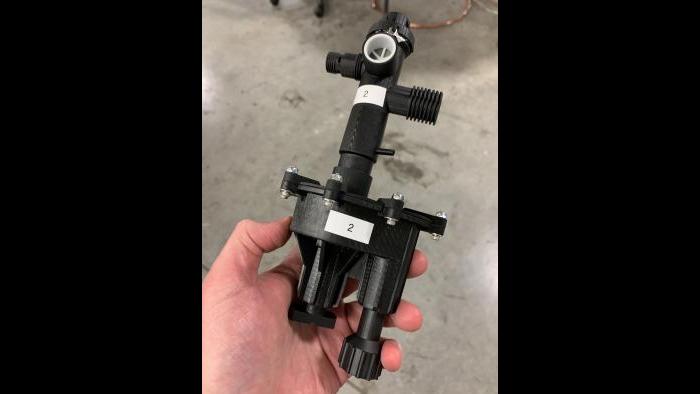It isn’t a widespread problem in Illinois yet. Gov. J.B. Pritkzer on Tuesday said that COVID-19 patients are using approximately 24% of ventilators available statewide. But there’s concern that as Illinois sees exponential rises in confirmed cases of the coronavirus, health care facilities will run out of the breathing machines.
A couple of weeks ago, administrators from Urbana-based Carle Health approached the University of Illinois at Urbana-Champaign in anticipation of that happening.
“We immediately went to work, we assembled a team of about 40 engineers, physicians and designers and we came up with a solution. We’ve been working around the clock for about two weeks,” said William King, professor of mechanical engineering under the colleges of both engineering and medicine. “We are living in the ‘Apollo 13’ movie. It’s a group of people that came together to solve a common problem on an extremely urgent emergency basis. That’s what it feels like.”
They came up with an initial prototype in short order, within about 160 hours, King said.
“As any engineer will tell you, the first prototype, it never works. We were delighted and overjoyed to see this first one. It was great,” he said with a smile.
Some roughly 2,000 human hours later, the end result was born: A hand-held, gas-powered, portable ventilator dubbed Rapid Vent that hospitals will be able to use should they need to convert non-intensive care unit rooms, which are equipped with electrical outlets to plug in regular ventilators, into ICU-type rooms.
On Monday, UIUC made available on its website plans for its new emergency ventilator available, free of charge, as a nonexclusive license. The university is hoping to find a partner that will produce the devices in time for a COVID-19 surge, which officials have predicted could hit Illinois by mid-April.
“How can we most quickly begin to translate this technology so it can get into the hands of physicians within, let’s say, two to four weeks,” UIUC engineering college Dean Rashid Bashir said. “The fact is that from the time that a manufacturer chooses to start to produce these, it could take two to four weeks to actually get these to the hospital and the health care providers. So the team, as quickly as it could and as rapidly as it could, came up with the design and then came up with the prototypes and then tested them.”
He said there are Illinois manufactures with the capability to do so, but they will need to get emergency approval from the federal Food and Drug Administration.
“There are actually small businesses in Illinois for example that are qualified to produce these, but there is an upfront investment that is needed. Also any company that now chooses to take these on or chooses to produce any other bio-medical product to address this current need, they need to get FDA approval through a process called EUA, Emergency Use Authorization, they can follow through with. So at this point what we’re looking to do is work with such potential partners,” Bashir said.
Follow Amanda Vinicky on Twitter: @AmandaVinicky










